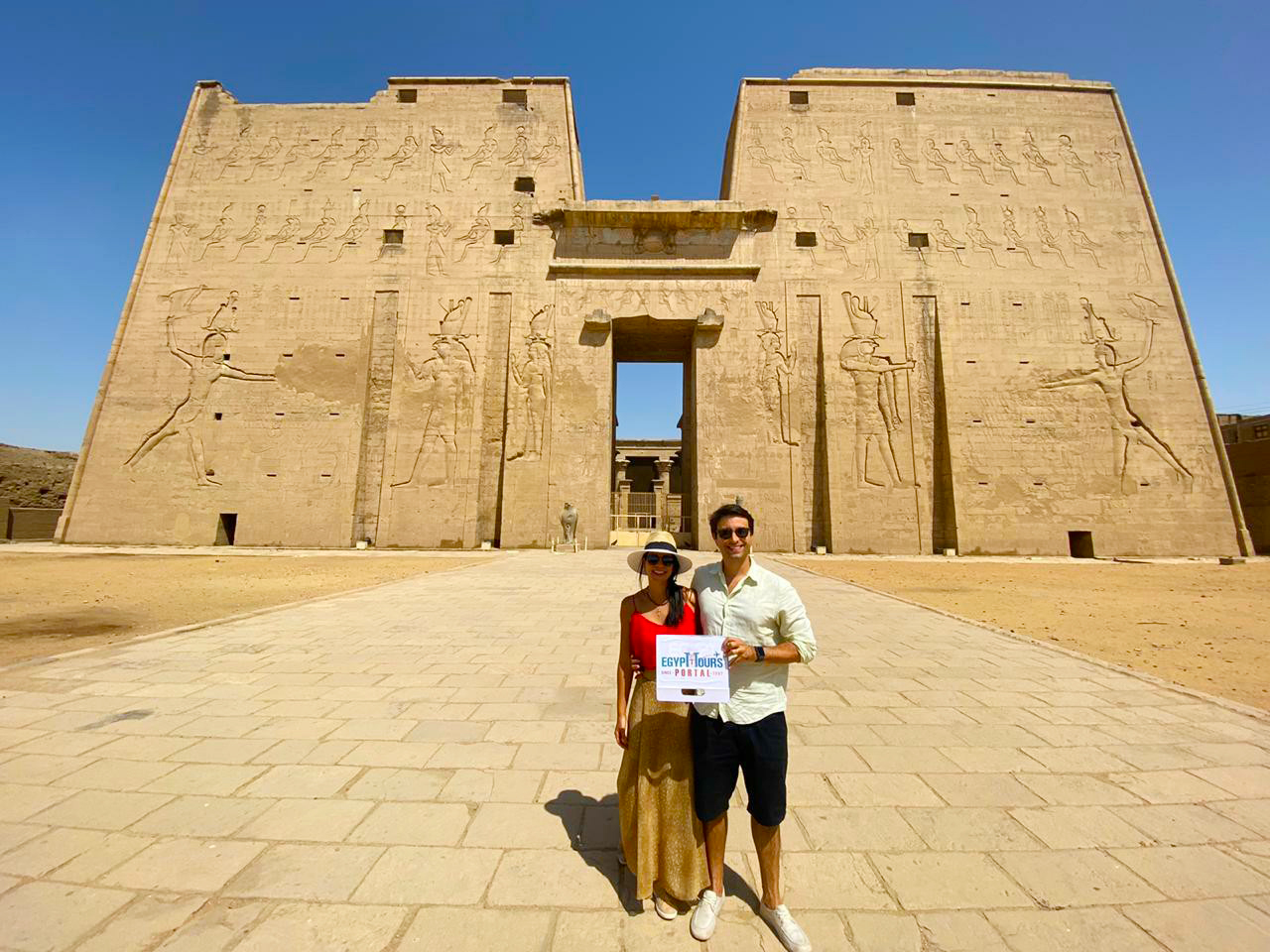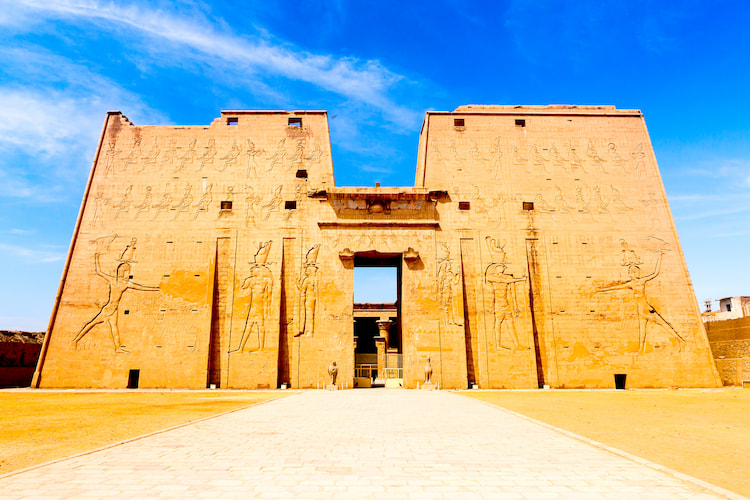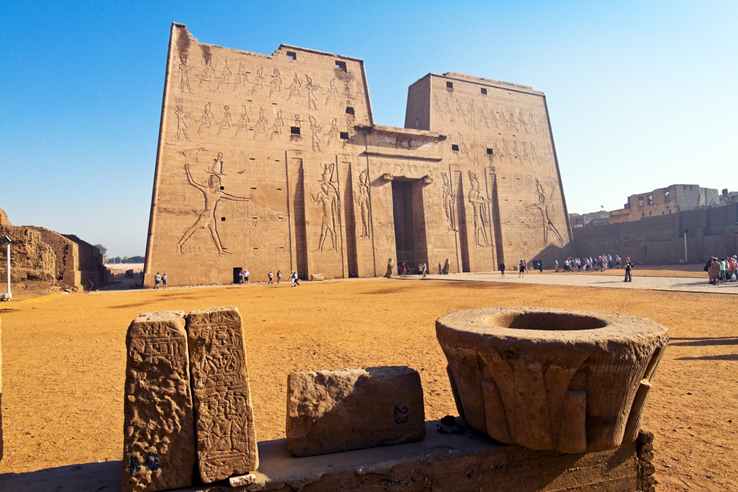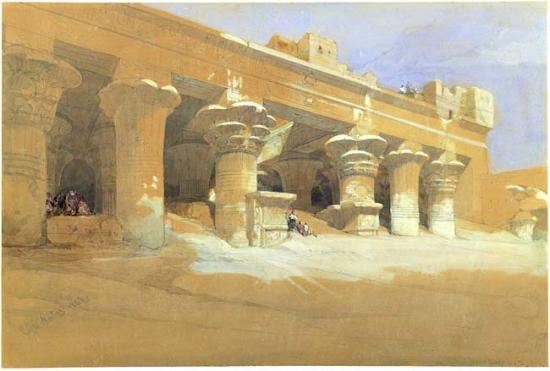The Mysteries and Legends of the Ancient Temple of Horus at Edfu
Welcome to an intriguing journey into the past as we explore the mysteries and legends surrounding the ancient Temple of Horus at Edfu. This temple, located on the west bank of the Nile in Egypt, is one of the largest and best-preserved temples from the ancient world, dedicated to the powerful god Horus. The temple's grandeur and intricate design have captivated scholars, archaeologists, and tourists alike, with its walls covered in intricate hieroglyphics and secret rooms that conceal ancient legends. In this blog post, we delve deep into the rich history of this temple, uncovering its secrets and discovering the legends surrounding it. Join us on this journey into the heart of ancient Egypt as we explore the enigmatic Temple of Horus at Edfu.

Explanation of the topic: Discussing the Temple of Horus in Edfu, Egypt and the significance of the god Horus in ancient Egyptian religion.
The Temple of Horus at Edfu, located midway between Luxor and Aswan on the west bank of the Nile River, is one of the best-preserved ancient temples in Egypt. Horus was a major deity in ancient Egyptian religion, and the temple is dedicated to his worship. This stunning temple is the most impressive structure in Edfu, a significant ancient city.
The temple has a fascinating history, dating back to the Ptolemaic era (305-282 BC) when it was built to replace an earlier temple that had been destroyed. The construction of this temple took almost two centuries, and it was completed during the reign of the Roman Emperor Trajan. The temple's size, beauty, and religious significance are astounding.
The temple was discovered in 1798 by a French team that had accompanied Napolean's expedition to Egypt. For more than a century after its discovery, the temple remained buried under sand and debris until it was finally excavated and restored in the late 19th and early 20th centuries. Since then, the temple has been a major tourist attraction and a source of fascination and wonder for all who visit it.
The temple's architecture is remarkable. The towering entrance pylon and high ceilings are awe-inspiring, and the temple's walls are adorned with fantastic reliefs depicting scenes of Horus's battles with his enemies. The temple is also home to an array of hieroglyphic inscriptions and magnificent artwork that offer a glimpse into ancient Egyptians' religious and cultural beliefs.
The temple holds an important place in ancient Egyptian religion. It was an essential centre of worship for Horus and played a significant role in religious ceremonies, including the annual Horus Festival. As a quote from Egyptologist James Henry Breasted suggests, "The temple of Horus at Edfu is one of the most perfect examples of its class, illustrating in every detail the life and faith of the ancient Egyptian religion."
The Temple of Horus at Edfu is a magnificent testament to the power and significance of an ancient civilization. It provides a glimpse into a bygone era's spiritual and cultural practices and remains a symbol of the enduring legacy of ancient Egyptian religion.

A brief history of the city of Edfu and its significance in ancient Egypt.
Edfu is one of the most important cities in Egypt, with a rich and fascinating history that dates back thousands of years. The city is located on the west bank of the Nile in Upper Egypt and is named after the chief god Horus, who was identified as the city's protector. Edfu was a significant religious centre in ancient Egypt, and its magnificent temple, the Temple of Horus, is one of the best-preserved shrines in Egypt.
The city of Edfu has a long and storied past, with its origins dating back to the times of ancient Egypt. It was an important religion, trade, and agriculture centre during the Pharaonic period. The city was home to several important temples, including the Temple of Horus, built during the Ptolemaic Period between 237 and 57 BC. The temple was a centre for religious ceremonies, and it was believed to be where the gods descended from the heavens to bless the people of Egypt.
The city of Edfu played an important role in the political and cultural life of ancient Egypt, and it was the site of several important events in the country's history. One of the most significant was the annual festival of Horus, which honoured the god and his wife, Hathor. The festival was a major event in Egyptian culture, and people from all over Egypt would flock to Edfu to participate in the celebrations.
Despite its importance, Edfu fell into disuse as a religious monument following the edict banning non-Christian worship within the Roman Empire in 391. Over the centuries, the temple became buried beneath the sand, and it was only rediscovered in 1798 by a French expedition. Today, the Temple of Horus in Edfu stands as a testament to the enduring legacy of ancient Egypt and the importance of this remarkable city in the country's history. [5][6]

Overview of the construction and features of the Temple of Horus.
The Temple of Horus in Edfu, Egypt, is one of the most well-preserved shrines in the country. Its construction began during the reign of Ptolemy III between 237 and 57 BC and took 180 years to complete, with contributions made by both Ptolemaic and Roman rulers.
The temple combines traditional Egyptian temple elements with a few Greek elements. It is oriented north-south and surrounded by a protective wall, with the main entrance marked by a grand pylon standing 37 meters tall. The pylon features intricate battle scenes and inscriptions that provide important information on the temple's construction and religious significance.
The courtyard also called the court of offerings, was open to the public and allowed worshippers to give offerings to the statue of the god. The rectangular Hypostyle Hall is supported by 12 columns on each side and features falcon-shaped statues of Horus of Behdet.
The Inner Hypostyle Hall leads to a sanctuary that once housed a statue of the god. At the same time, the outer vestibule, known as the Hall of Offerings, features walls decorated with different scenes of deities and offerings made by the Ptolemaic kings. The temple also had a nilometer, a pillar used to measure the height of the Nile River, and a chapel dedicated to the goddess Nut.
Overall, the construction and features of the Temple of Horus in Edfu provide important insights into ancient Egypt's religious practices and myths, making it a noteworthy monument for visitors to explore. [7][8]

Discussion of the rumours surrounding the temple's burial.
Rumours have surrounded the Temple of Horus at Edfu since its discovery and excavation in the mid-19th century. One of the most popular is that the temple was buried intentionally under the sand to hide it from view. According to some natives, the pagan worshipers of the cult of Horus cast a spell to hide the temple from sight if they were not allowed to use it to praise Horus in modern times. However, there is no concrete evidence to support this claim.
Another rumour is that looters or pagans plundered the temple, so many original artwork and structures are missing. Considering that the temple went through many natural disasters during its time, it is plausible that it suffered some damage over the centuries. However, the modern preservation team has done a great job bringing the ruined artefact back to life.
Despite these rumours, the Temple of Horus at Edfu remains a magnificent structure that has stood the test of time. Its roof stands tall, and its grand entrance and high ceilings are awe-inspiring. Inside the sanctuary, remnants of ancient Egyptian life can be found on the walls, providing important information on language, myth, and religion during ancient Egypt. The temple's inscriptions and building texts provide details of its construction and preserve information about the mythical interpretation of this and all other temples as the Island of Creation.
The Temple of Horus was an important place of religious significance for the ancient Egyptians and continues to be so today. Its archaeological significance and high state of preservation make it a centre for tourism and a frequent stop for the many that cruise the Nile. Today, the temple is nearly intact and is a good example of an ancient Egyptian temple. [11][12]

The Temple's Architecture
The Temple of Horus at Edfu is an awe-inspiring architecture, boasting grand entrances and high ceilings that invoke a sense of magnificence and majesty. The temple's main entrance, the "Pylon," is flanked by soaring towers and decorated with bas-relief carvings of Horus and other Egyptian gods. The entrance leads into a large courtyard surrounded by columns, which give way to the hypostyle hall, a monumental chamber supported by 18 columns that tower over 21 meters high.
The temple's ceiling is also decorated with astronomical representations, and the walls are adorned with images of Ptolemaic monarchs. In the anteroom of the sanctuary, visitors can see the sacred boat and the granite monolith that housed the golden image of the temple deity, Horus. The sanctuary is a masterpiece of ancient Egyptian architecture, with intricate carvings and reliefs depicting the stories and myths associated with the god Horus.
The temple's high ceilings are particularly impressive, with some reaching up to 21 meters. The towering columns that support the roof are covered in hieroglyphs and intricate carvings that detail the life of Horus and his importance in the ancient Egyptian pantheon. Visitors to the Temple of Horus at Edfu are left in awe of the sheer scale and complexity of the temple's architecture. One visitor notes, "It's incredible to think that people over 2,000 years ago could build such a magnificent temple. It truly is a testament to the ingenuity and creativity of the ancient Egyptians." [13][14]

Discussion of the relics and artwork found within the temple.
The Temple of Horus in Edfu, Egypt is an incredible archaeological wonder with many amazing aspects. One such aspect is the relics and artwork found within the temple. The artwork within the temple depicts images of the gods and pharaohs, as well as scenes from ancient Egyptian mythology. The walls are filled with hieroglyphics that have been well-preserved and are a great source of information about ancient Egyptian history and culture. The temple also contains a lot of amazing relics such as the black granite shrine in the Sanctuary of Horus that was decorated by Nectanebo II. The shrine is a stunning piece of art that showcases the skill and artistry of ancient Egyptian craftsmen. Additionally, the temple contains a large number of statues of Horus, as well as other gods and goddesses. These statues are made of various materials such as granite, sandstone, and limestone and are intricately carved with detail. Furthermore, the temple has a lot of beautiful wall carvings and paintings that are still vibrant and colorful after all these years. According to Edfu Temple Facts, the temple has a hypostyle hall that was constructed by Ptolemy VII filled with a decorated ceiling with marvelous astronomical painting and a hall of festivals. All of these relics and artwork provide a glimpse into the religious ceremonies and beliefs of ancient Egyptians and make the Temple of Horus at Edfu a must-visit destination for anyone fascinated by ancient Egypt. As the Ancient Origins says, "Edfu Texts which seem to cover every available surface." [15][16]

Overview of the importance of the Temple of Horus in ancient Egyptian religion.
The Temple of Horus in Edfu played a crucial role in the ancient Egyptian religion. It was not just a temple but a site of ritual and sacrifice, where the people of Edfu believed their god resided. The importance of the temple lies in its ability to allow devotees to connect with the divine and experience the power of Horus in their lives. The Temple of Horus was a centre of religious and political power in ancient Egypt, and its influence on the daily lives of the people of Edfu was immense.
The temple reflects the grandeur and sophistication of ancient Egyptian architecture and art. It is one of the best-preserved temples in Egypt, providing insights into the building and religious practices of the ancient Egyptians. Inside the temple, one can see many inscriptions and murals that depict religious and historical events. The temple also contains many sculptures and artefacts that testify to ancient Egyptian civilisation's religious and artistic achievements.
The Temple of Horus had a special significance in the religious ceremonies of ancient Egypt. It was believed that the temple was the site of the annual festival of Horus, during which the statue of the god was carried in a procession around the temple. The procession was accompanied by music, dancing, and ritual offerings to the god. People from all over Egypt came to Edfu to participate in these festivals and to pay their respects to the god Horus.
The Temple of Horus in Edfu was a place of great religious significance for the ancient Egyptians. It was a symbol of the power of the gods and their influence on the people's lives. The temple's grandeur and architectural achievements are a testament to ancient Egyptian culture's sophistication. It continues to be a popular tourist destination and a reminder of the ancient history and religious practices that have shaped our world. [17][18]

Explanation of the worship of Horus and the role of the temple in religious ceremonies.
The worship of Horus was an integral element of ancient Egyptian religion, and the Temple of Horus in Edfu played a crucial role in religious ceremonies. Horus was considered the sky god with immense powers and bravery, and the people would pray, sacrifice, and bow before him.
The temple, constructed between 237 and 57 B.C.E., was dedicated to Horus. The people of Edfu believed that Horus favoured their city, and the temple, being one of the largest and most well-preserved temples in Egypt, had grand and awe-inspiring architecture, with high ceilings, pillars around the main building, and intricate artwork.
The ancient Egyptian civilization was polytheistic, and the practice of worshipping statues of gods was widespread. In this context, the Temple of Horus was of immense significance as a place to worship and praise Horus. The temple was of great religious importance to people, and it eventually became the centre of several festivals sacred to Horus, including the occasion of the sacred marriage between Horus and Hathor.
Each year, Hathor would travel from her temple to visit Horus in Edfu, marking the occasion of a great festival and pilgrimage. Consequently, the temple of Horus at Edfu is an essential site for comprehending ancient Egyptian religion and culture. [19][20]
